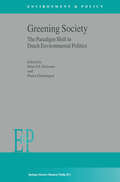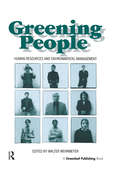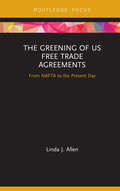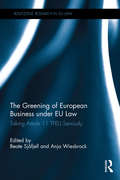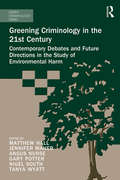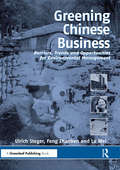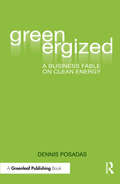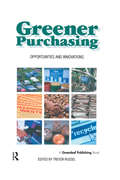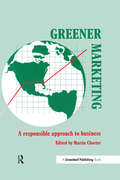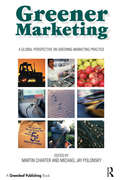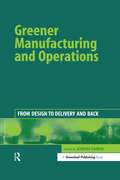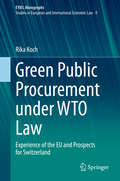- Table View
- List View
Greening Society: The Paradigm Shift in Dutch Environmental Politics (Environment & Policy #33)
by PieterGlasbergen Peter P. J.DriessenThis book can be regarded as a monograph on the debates and developments in Dutch environmental policy. It has been written with a specific perspective in mind. First and foremost, the line of approach we have taken was from a multidisciplinary social science point of view. The trend in environmental policy is looked at from the angle of sociology, policy studies and political science. Secondly, all analyses depart from the paradigm shift concept. This particular paradigm shift is based on the fact that a radical change has taken shape over the years in the way environmental issues are handled. Previously, environmental policy had always been characterised by is top-down approach in which government determined the actual objectives of policy and assumed that it could win over business, non governmental organisations and citizens to act in line with those objectives. There was also a great deal of faith in the technical solutions to environmental issues. Today's environmental policy is based on a totally different philosophy. Environmental objectives are now reached in association with business, non-governmental organisations and citizens. These actors are also involved in bringing environmental policy into practice. In other words, the implementation of policy has a more interactive nature. New relationships emerge between government, the market and civil society, and policy discourses also become integrated. The environmental interest is more often weighed against the econom1c interests, the spatial development and against social justice.
Greening People: Human Resources and Environmental Management
by Walter WehrmeyerThis major collection examines both the human resource dimensions of environmental management and how environmental management impacts on human resource departments. Contributions from international experts in both academia and business look at current theory and best practice in environmental TQM, education, training and communications. Greening People argues that, if a company is to adopt an environmentally-aware approach to its activities, the employees are the key to success or failure. Realistically, it is only through the energy, performance and personal commitment of each employee within an organization that business will move towards sustainable industrial development. This book provides an important angle on the new complexities faced by environmental managers and human resource professionals and offers practical solutions drawn from some of the leading lights in the corporate environmental revolution. Greening People is divided into four parts. Part 1 demonstrates the relationship between human resource management and environmental management. Part 2 provides insight into the psychological make-up of contemporary staff that may foster or hinder company-wide implementation of environmental measures, and Part 3 addresses the shortcomings of current management training programmes and suggests new approaches for effective implementation of environmental human resource management. Finally, a selection of excellent case studies demonstrates how the concepts are being implemented in companies and local authorities.
Greening People: Human Resources and Environmental Management
by Walter WehrmeyerThis major collection examines both the human resource dimensions of environmental management and how environmental management impacts on human resource departments. Contributions from international experts in both academia and business look at current theory and best practice in environmental TQM, education, training and communications. Greening People argues that, if a company is to adopt an environmentally-aware approach to its activities, the employees are the key to success or failure. Realistically, it is only through the energy, performance and personal commitment of each employee within an organization that business will move towards sustainable industrial development. This book provides an important angle on the new complexities faced by environmental managers and human resource professionals and offers practical solutions drawn from some of the leading lights in the corporate environmental revolution. Greening People is divided into four parts. Part 1 demonstrates the relationship between human resource management and environmental management. Part 2 provides insight into the psychological make-up of contemporary staff that may foster or hinder company-wide implementation of environmental measures, and Part 3 addresses the shortcomings of current management training programmes and suggests new approaches for effective implementation of environmental human resource management. Finally, a selection of excellent case studies demonstrates how the concepts are being implemented in companies and local authorities.
The Greening of US Free Trade Agreements: From NAFTA to the Present Day (Routledge Focus on Environment and Sustainability)
by Linda AllenThis book provides an up-to-date critical analysis of the integration of environmental policies into US free trade agreements. The work focuses on the evolution of the design of environmental policies and analyzes their effectiveness. Starting with the North American Free Trade Agreement (NAFTA) leading to the Trans-Pacific Partnership (TPP), the book examines the history of policy integration. In doing so, it provides an overview of the major trade-related environmental policies and presents empirical research on their effectiveness, a discussion of the continued demand for policy integration in light of the effectiveness, and recommendations for addressing shortcomings. The main objective of the book is to inform the ongoing policy debate over integration of environmental policies into trade agreements. The current renegotiation of NAFTA provides an opportune time for undertaking this critical review of trade-related environmental policies. As our understanding and knowledge of the environmental policies associated with US trade agreements, in particular for NAFTA, has grown significantly over the past twenty-five years, this book provides a timely and critical update for this policy debate. Students and scholars of environmental law, trade and economics, and specifically US trade, environmental policy and law will find this book of great interest.
The Greening of US Free Trade Agreements: From NAFTA to the Present Day (Routledge Focus on Environment and Sustainability)
by Linda AllenThis book provides an up-to-date critical analysis of the integration of environmental policies into US free trade agreements. The work focuses on the evolution of the design of environmental policies and analyzes their effectiveness. Starting with the North American Free Trade Agreement (NAFTA) leading to the Trans-Pacific Partnership (TPP), the book examines the history of policy integration. In doing so, it provides an overview of the major trade-related environmental policies and presents empirical research on their effectiveness, a discussion of the continued demand for policy integration in light of the effectiveness, and recommendations for addressing shortcomings. The main objective of the book is to inform the ongoing policy debate over integration of environmental policies into trade agreements. The current renegotiation of NAFTA provides an opportune time for undertaking this critical review of trade-related environmental policies. As our understanding and knowledge of the environmental policies associated with US trade agreements, in particular for NAFTA, has grown significantly over the past twenty-five years, this book provides a timely and critical update for this policy debate. Students and scholars of environmental law, trade and economics, and specifically US trade, environmental policy and law will find this book of great interest.
The Greening of European Business under EU Law: Taking Article 11 TFEU Seriously (Routledge Research in EU Law)
by Beate Sjåfjell Anja WiesbrockThe relationship between environmentally sustainable development and company and business law has emerged in recent years as a matter of major concern for many scholars, policy-makers, businesses and nongovernmental organisations. This book offers a conceptual analysis of the principles of sustainable development and environmental integration in the EU legal system. It particularly focuses on Article 11 of the Treaty on the Functioning of the European Union (TFEU), which states that EU activities must integrate environmental protection requirements and emphasise the promotion of sustainable development. The book gives an overview of the role played by the environmental integration principle in EU law, both at the level of European legislation and at the level of Member State practice. Contributors to the volume identify and analyse the main legal issues related to the importance of Article 11 TFEU in various policy areas of EU law affecting European businesses, such as company law, insurance and state aid. In drawing together these strands the book sets out the requirements of environmental integration and examines its impact on the regulation of business in the EU. The book will be of great use and interest to students and researchers of business law, environment law, and EU law.
The Greening of European Business under EU Law: Taking Article 11 TFEU Seriously (Routledge Research in EU Law)
by Beate Sjåfjell Anja WiesbrockThe relationship between environmentally sustainable development and company and business law has emerged in recent years as a matter of major concern for many scholars, policy-makers, businesses and nongovernmental organisations. This book offers a conceptual analysis of the principles of sustainable development and environmental integration in the EU legal system. It particularly focuses on Article 11 of the Treaty on the Functioning of the European Union (TFEU), which states that EU activities must integrate environmental protection requirements and emphasise the promotion of sustainable development. The book gives an overview of the role played by the environmental integration principle in EU law, both at the level of European legislation and at the level of Member State practice. Contributors to the volume identify and analyse the main legal issues related to the importance of Article 11 TFEU in various policy areas of EU law affecting European businesses, such as company law, insurance and state aid. In drawing together these strands the book sets out the requirements of environmental integration and examines its impact on the regulation of business in the EU. The book will be of great use and interest to students and researchers of business law, environment law, and EU law.
Greening Criminology in the 21st Century: Contemporary debates and future directions in the study of environmental harm (Green Criminology)
by Matthew Hall Tanya Wyatt Nigel South Angus Nurse Gary Potter Jennifer MaherIn the 21st century, environmental harm is an ever-present reality of our globalised world. Over the last 20 years, criminologists, working alongside a range of other disciplines from the social and physical sciences, have made great strides in their understanding of how different institutions in society, and criminal justice systems in particular – respond – or fail to respond – to the harm imposed on ecosystems and their human and non-human components. Such research has crystallised into the rapidly evolving field of green criminology. This pioneering volume, with contributions from leading experts along with younger scholars, represents the state of the art in criminologists’ pursuit of understanding in the environmental sphere while at the same time challenging academics, lawmakers and policy developers to explore new directions in the study of environmental harm.
Greening Criminology in the 21st Century: Contemporary debates and future directions in the study of environmental harm (Green Criminology)
by Matthew Hall Tanya Wyatt Nigel South Angus Nurse Gary Potter Jennifer MaherIn the 21st century, environmental harm is an ever-present reality of our globalised world. Over the last 20 years, criminologists, working alongside a range of other disciplines from the social and physical sciences, have made great strides in their understanding of how different institutions in society, and criminal justice systems in particular – respond – or fail to respond – to the harm imposed on ecosystems and their human and non-human components. Such research has crystallised into the rapidly evolving field of green criminology. This pioneering volume, with contributions from leading experts along with younger scholars, represents the state of the art in criminologists’ pursuit of understanding in the environmental sphere while at the same time challenging academics, lawmakers and policy developers to explore new directions in the study of environmental harm.
Greening Chinese Business: Barriers, Trends and Opportunities for Environmental Management
by Lu Wei Fang Zhaoben Ulrich StegerEnvironmental regulation in China is not really different from that in the rest of the world, except that environmental authorities are relatively new and less established. In order to understand why corporate environmental performance has hardly improved despite the existing regulatory framework, empirical research on high-level executives' perceptions of environmental protection is essential. This unique book analyses and interprets Chinese managers' perceptions of environmental management and regulatory enforcement practices in Chinese enterprises. Most importantly, it identifies the bottlenecks to environmental protection in Chinese firms. It includes a detailed analysis of the needs for management training (for example, CEO and executive development and MBA education) in China and presents a roadmap of how they can be met. Finally, it presents two case studies that illustrate how Chinese corporations currently react to a wide range of different environmental challenges, including hardening regulatory pressure, competition and lack of capital. Based on an innovative research project sponsored by the UNESCO/UNDP offices in Beijing and undertaken by the Institute for Management Development (IMD), Lausanne, Switzerland and the Business School of the Academy of Science and Technology (USTC), Hefei, China, Greening Chinese Business provides the first hard empirical evidence of how Chinese managers view environmental protection. Over 300 companies-both state-owned enterprises and SMEs-took part in the research. Key findings includeAround 70% of managers surveyed admit moderate or even heavy environmental impact (this is a subjective assessment without an external benchmark). Furthermore, they indicate that the lack of environmental performance is primarily due to insufficient managerial expertise, capital and employment-related protectionism. Managers hesitate to take necessary action to upgrade technical equipment, because, although decreasing pollution, upgrading would lead to lay-offs that, in turn, would diminish social stability. Since the latter is first priority in China, managers fear loss of their companies'-and, attached to that, their personal-image, which plays a very important role in Chinese culture. Regulative enforcement has been strong enough to put environmental management on the "to do" lists of Chinese managers. Nevertheless, managers criticise existing enforcement practices as being too lax and untransparent (due to local protectionism, bribery and lack of expertise in the enforcement institutions). Managers consider environmental functionaries-the Chinese equivalent of an environmental protection agency-and the government to be the most important environmental stakeholders. This is a clear sign for their predominantly reactive attitude towards environmental protection: few Chinese companies are going beyond compliance and pioneering integrated approaches to pollution prevention. The research shows similarities between current Chinese company approaches and the "state of the art" in industrial centres of OECD countries such as Germany in the 1960s. Apart from a lack of capital, managers cite a lack of expertise-managerial more than technical-as the main obstacle to "greening" their organisations. Environmental management programmes need to be developed: competence-building should start with CEOs and executives. Greening Chinese Business will aid readers to understand how: Chinese managers perceive and react to the increasing (more external than internal) pressure to improve environmental protection; understand the regulatory, public and business environment in which Chinese managers make decisions about environmental protection; understand the potential for improvement of this regulatory, public and business environment, either as a manager or an external stakeholder and develop strategies that lead to improved stakeholder relationships and, consequently, to competitive advantage; understand the urgent need to develop environmental management practices in Chi
Greenhouse Gas Emissions: Global Business Aspects
by Michael SeeThe world is getting hotter as it experiences the extremes of global climate change. In 1999, catastrophic storms hit Honduras, China and East India, bringing severe devas tation to lives and national economies. EI Nino swept across the Pacific in early 2000, inflicting the worst floods on Mozambique and neighbouring countries. Industrialised nations are not immune to global warming - cases of encephalitis, a disease trans mitted by mosquitoes, were reported in the State of New York. In Antarctica, an iceberg seven times the size of Manhattan island broke loose and floated towards Cape Horn. The melting of Arctic glaciers also continues - huge volumes of fresh-water will disrupt the warm conveyor-belt from Central America to Europe. The net effect of convergent glacial drifts from the polar regions to the equator is expected to inten sify cloud formation in the tropics - hence exacerbating global warming. As the destructive forces of nature intensify, so does the rhetoric from environmental organ isations - as evidenced by the disruption of the last World Trade Organisation con ference in Seattle. It is now up to civilisation to challenge climate change. It can achieve this by command and control as well as flexible mechanisms at home and abroad, before the process of global warming becomes totally irreversible.
The Greenhouse Gas Balance of Italy: An Insight on Managed and Natural Terrestrial Ecosystems (Environmental Science and Engineering)
by Riccardo Valentini Franco MigliettaThe book addresses in a comprehensive way the full greenhouse gases budget of the Italian landscape, focusing on land use and terrestrial ecosystems. In recent years there has been a growing interest in the role of terrestrial ecosystems with regard to the carbon cycle and only recently a regional approach has been considered for its specificity in terms of new methodologies for observations and models and its relevance for national policies on mitigation and adaptation to climate changes. In terms of methods this book describes the role of flux networks and data-driven models, airborne regional measurements of fluxes and specific sectoral approaches related to important components of the human and natural landscapes. There is also a growing need on the part of institutions, agencies and policy stakeholders for new data and analyses enabling them to improve their national inventories of greenhouse gases and their compliance with the UNFCCC process. In this respect the data presented is a basis for a full carbon accounting and available to relevant stakeholders for improvements and/or verification of national inventories. The wealth of research information is the result of a national project, CARBOITALY, which involved 15 Italian institutions and several researchers to provide new data and analyses in the framework of climate policies.
Greenergized: A Business Fable on Clean Energy
by Dennis PosadasRenewable energy versus fossil fuels: the debate rages on, worldwide. At stake is nothing less than the protection of our planet from the ravages of climate change. But the costs involved in making the switch to clean energy are daunting. How do we pay for solar and wind energy? Do we scrap all our gasoline-driven autos? How do we move forward?Although the importance of this topic is hard to overstate, it nevertheless consistently fails to engage at the level that it so patently needs to. This is what has led technology expert and seasoned commentator Dennis Posadas to approach the issues in a new and intriguing way. Posadas understands that we respond best to narratives, and that is why he has written what he describes as a "green thinking fable". In this fable, we meet Daniel, a young graduate of the fictional Oriental College, who is thrust into a debate between José, an oil man, and Professor Ruiz, an advocate of clean energy. We follow the lines of argument as Daniel's awareness increases, and he experiences a paradigm shift in his thinking. We see how his short-term outlook focusing on the cost of renewable energy evolves into long-term thinking about the cost of not making the shift to renewables. Posadas's business fable puts the issues in front of the general reader in an engaging and digestible way. It covers concepts such as solar, wind, electric vehicles, waste to energy, feed-in-tariffs, carbon tax, intermittent sources, cost of fossil fuels, health impact of fossil fuel use, energy efficiency, and other relevant topics necessary for understanding this debate. The story and characters may be fictional, but the situations and the technology discussions are based on current facts. Decide for yourself where you stand on the renewables versus fossil fuels debate, and discuss this story with your friends and colleagues. Greenergized is a much-needed route into the issues surrounding the most serious debate our generation faces. And it pulls off the brilliant trick of being highly readable at the same time.
Greenergized: A Business Fable on Clean Energy
by Dennis PosadasRenewable energy versus fossil fuels: the debate rages on, worldwide. At stake is nothing less than the protection of our planet from the ravages of climate change. But the costs involved in making the switch to clean energy are daunting. How do we pay for solar and wind energy? Do we scrap all our gasoline-driven autos? How do we move forward?Although the importance of this topic is hard to overstate, it nevertheless consistently fails to engage at the level that it so patently needs to. This is what has led technology expert and seasoned commentator Dennis Posadas to approach the issues in a new and intriguing way. Posadas understands that we respond best to narratives, and that is why he has written what he describes as a "green thinking fable". In this fable, we meet Daniel, a young graduate of the fictional Oriental College, who is thrust into a debate between José, an oil man, and Professor Ruiz, an advocate of clean energy. We follow the lines of argument as Daniel's awareness increases, and he experiences a paradigm shift in his thinking. We see how his short-term outlook focusing on the cost of renewable energy evolves into long-term thinking about the cost of not making the shift to renewables. Posadas's business fable puts the issues in front of the general reader in an engaging and digestible way. It covers concepts such as solar, wind, electric vehicles, waste to energy, feed-in-tariffs, carbon tax, intermittent sources, cost of fossil fuels, health impact of fossil fuel use, energy efficiency, and other relevant topics necessary for understanding this debate. The story and characters may be fictional, but the situations and the technology discussions are based on current facts. Decide for yourself where you stand on the renewables versus fossil fuels debate, and discuss this story with your friends and colleagues. Greenergized is a much-needed route into the issues surrounding the most serious debate our generation faces. And it pulls off the brilliant trick of being highly readable at the same time.
Greener Purchasing: Opportunities and Innovations
by Trevor RusselEvery organization, public and private, no matter what its size, purchases goods and services. Large organizations also have considerable influence over the practices of their suppliers. As greener purchasing practices have become more common in large organisations, the implications for companies in the supply chain have similarly increased. Yet greener purchasing policies remain the exception rather than the norm in large organizations. Why is this? And how can environmental purchasing practices that have produced tangible business benefits for a number of companies worldwide receive wider take-up? Greener Purchasing: Opportunities and Innovations has been published to facilitate the development and dissemination of best practice in environmental supply chain and procurement management worldwide. Divided into four sections, covering "The Public Sector", "The Private Sector", "Innovations" and "Case Studies", this book brings together international expertise from four continents, including contributions from organisations such as the US EPA, Environment Canada, Procter & Gamble, Xerox and The Body Shop, as well as describing burgeoning new initiatives such as the Japanese and European Green Purchasing Networks. It provides a number of checklists and examples on how to establish and maintain successful greener purchasing and supply chain practices in order to bring not only environmental, but business value to organisations of all sizes. The book is essential reading for purchasing officers, environmental managers, CEOs, consultants, academics and students interested in the topic around the world.
Greener Purchasing: Opportunities and Innovations
by Trevor RusselEvery organization, public and private, no matter what its size, purchases goods and services. Large organizations also have considerable influence over the practices of their suppliers. As greener purchasing practices have become more common in large organisations, the implications for companies in the supply chain have similarly increased. Yet greener purchasing policies remain the exception rather than the norm in large organizations. Why is this? And how can environmental purchasing practices that have produced tangible business benefits for a number of companies worldwide receive wider take-up? Greener Purchasing: Opportunities and Innovations has been published to facilitate the development and dissemination of best practice in environmental supply chain and procurement management worldwide. Divided into four sections, covering "The Public Sector", "The Private Sector", "Innovations" and "Case Studies", this book brings together international expertise from four continents, including contributions from organisations such as the US EPA, Environment Canada, Procter & Gamble, Xerox and The Body Shop, as well as describing burgeoning new initiatives such as the Japanese and European Green Purchasing Networks. It provides a number of checklists and examples on how to establish and maintain successful greener purchasing and supply chain practices in order to bring not only environmental, but business value to organisations of all sizes. The book is essential reading for purchasing officers, environmental managers, CEOs, consultants, academics and students interested in the topic around the world.
Greener Marketing: A Responsible Approach to Business
by Martin CharterAn examination of the progress of environmental marketing on a global scale. It considers how sustainability issues are increasingly becoming critical factors in how corporations meet the ever-growing demands and expectations of customers. The purpose of the book is to provide practitioners with best-practice examples and actionable recommendations on how to implement green marketing activities. It provides information and ideas for those involved in marketing on how to incorporate green considerations into the marketing mix, as well as providing perspectives on marketing for environmental managers. To achieve a comprehensive viewpoint, the book is split into three sections. The first sets out the strategic issues and rationale for green marketing, the second addresses tactical issues in more detail, and the third provides detailed, international case studies. Topics addressed by the contributors include the growing debate around products versus services, environmental product development and eco-innovation, green marketing alliances, environmental communications, green consumers, eco-tourism and the problems associated with green marketing in developing countries.
Greener Marketing: A Responsible Approach to Business
by Martin CharterAn examination of the progress of environmental marketing on a global scale. It considers how sustainability issues are increasingly becoming critical factors in how corporations meet the ever-growing demands and expectations of customers. The purpose of the book is to provide practitioners with best-practice examples and actionable recommendations on how to implement green marketing activities. It provides information and ideas for those involved in marketing on how to incorporate green considerations into the marketing mix, as well as providing perspectives on marketing for environmental managers. To achieve a comprehensive viewpoint, the book is split into three sections. The first sets out the strategic issues and rationale for green marketing, the second addresses tactical issues in more detail, and the third provides detailed, international case studies. Topics addressed by the contributors include the growing debate around products versus services, environmental product development and eco-innovation, green marketing alliances, environmental communications, green consumers, eco-tourism and the problems associated with green marketing in developing countries.
Greener Marketing: A Global Perspective on Greening Marketing Practice
by Martin Charter Michael Jay PolonskyBuilding on the strengths of the material published in the hugely successful first edition of Greener Marketing, this important new title examines on a global scale the progress of environmental marketing in the 1990s and considers how social issues are increasingly becoming critical factors in how corporations meet the ever-growing demands and expectations of customers. Despite the fact that such issues are increasingly important in marketing activities around the world, it is difficult for practitioners to keep up to date with complex and rapidly changing information and ideas. The purpose of this book is to provide practitioners and academics with best-practice examples and actionable recommendations on how to implement and appraise green marketing activities. It will provide information and ideas for those involved in marketing on how to incorporate environmental and social considerations, as well as providing new perspectives on marketing for environmental managers. To achieve a comprehensive viewpoint, the book is split into three sections. The first sets out the strategic issues and rationale for green marketing, the second addresses tactical issues in more detail, and the third provides detailed international case studies. Topics addressed by the global set of contributors include the growing area of products versus services, environmental product development, green marketing alliances, environmental communications, green consumers, eco-tourism and environmental marketing in developing countries. reener Marketing is not only a sequel to the successful first volume, but redefines global progress towards the successful marketing of greener products and services.
Greener Marketing: A Global Perspective on Greening Marketing Practice
by Martin Charter Michael Jay PolonskyBuilding on the strengths of the material published in the hugely successful first edition of Greener Marketing, this important new title examines on a global scale the progress of environmental marketing in the 1990s and considers how social issues are increasingly becoming critical factors in how corporations meet the ever-growing demands and expectations of customers. Despite the fact that such issues are increasingly important in marketing activities around the world, it is difficult for practitioners to keep up to date with complex and rapidly changing information and ideas. The purpose of this book is to provide practitioners and academics with best-practice examples and actionable recommendations on how to implement and appraise green marketing activities. It will provide information and ideas for those involved in marketing on how to incorporate environmental and social considerations, as well as providing new perspectives on marketing for environmental managers. To achieve a comprehensive viewpoint, the book is split into three sections. The first sets out the strategic issues and rationale for green marketing, the second addresses tactical issues in more detail, and the third provides detailed international case studies. Topics addressed by the global set of contributors include the growing area of products versus services, environmental product development, green marketing alliances, environmental communications, green consumers, eco-tourism and environmental marketing in developing countries. reener Marketing is not only a sequel to the successful first volume, but redefines global progress towards the successful marketing of greener products and services.
Greener Manufacturing and Operations: From Design to Delivery and Back
by Joseph SarkisThis timely work examines one core corporate function that has a profound and direct impact on corporate environmental performance – manufacturing and operations. This area has been of concern in recent years to researchers and practitioners in fields ranging from the social and natural sciences to management and technical engineering. The book reflects this diversity with global contributions on topics such as design for the environment, total quality environmental management, green supply chains, reverse logistics, environmental management systems and standards, industrial ecology, closed-loop manufacturing, life-cycle management, pollution prevention (P2), environmental technologies and energy efficiency. The aim and scope of Greener Manufacturing and Operations is to capture state-of-the-art and future practices in environmental manufacturing and operations practices and issues in one concise volume. The book is therefore a fluid mix of case studies, empirical research, and applied theoretical works incorporating both conceptual ideas whose time will come to practical applications which managers and practitioners can apply immediately. Comprehensive in its coverage of the key issues, contributions range from a focus on the internal operations of a single function within an organization to a consideration of industrial manufacturing practices from a macro-economic level. A number of levels of decision-making are also represented: from long-term strategic issues such as supply chain design, to traditional short-term operations decision-making and planning issues such as production planning. Many of the principles developed and presented here can also be extended to the more general process management of service organizations. The book is organized into four major sections: operations strategy and policy; manufacturing and operations practice; tools for managing greener operations and manufacturing; and, finally, case studies. Greener Manufacturing and Operations will be an essential aid for managers, engineers, students, researchers, and consultants wishing to understand the various issues, principles, and tools for managing the operations and manufacturing function in a more environmentally-benign and sustainable manner.
Green Zone: Imperial Life in the Emerald City
by Rajiv ChandrasekaranFrom inside a surreal bubble of pure Americana known as the Green Zone, the US-led Coalition Provisional Authority attempted to rule Iraq following the fall of Saddam Hussein's regime. Drawing on interviews and internal documents, Rajiv Chandrasekaran tells the memorable story of this ill-prepared attempt to build American democracy in a war-torn Middle Eastern country, detailing not only the risky disbanding of the Iraqi army and the ludicrous attempt to train the new police force, but absurdities such as the aide who based Baghdad's new traffic laws on those of the state of Maryland, downloaded from the net, and the twenty-four-year-old who had never worked in finance put in charge of revitalising Baghdad's stock exchange. Imperial Life in the Emerald City is American reportage at its best.
The Green Studio Handbook: Environmental Strategies for Schematic Design
by Alison G Kwok Walter GrondzikThe Green Studio Handbook remains an essential resource for design studios and professional practice. This extensive and user-friendly tool presents practical guidelines for the application of green strategies during the schematic design of buildings. Students and professionals can quickly get up to speed on system viability and sizing. Each of forty-three environmental strategies includes a brief description of principles and concepts, step-by-step guidance for integrating the strategy during the early stages of design, annotated tables and charts to assist with preliminary sizing, key issues to consider when implementing the strategy, and pointers to further resources. Ten new in-depth case studies illustrate diverse and successful green buildings integrated design projects and how the whole process comes together This third edition features updated tables and charts that will help to save energy, water, and material resources during the early stages of design. More than 500 sketches and full-color images illustrate how to successfully apply strategies. A glossary, a project index listing 105 buildings in 20 countries, updated tables and drawings, and I-P and SI units increase the usefulness of The Green Studio Handbook.
The Green Studio Handbook: Environmental Strategies for Schematic Design
by Alison G Kwok Walter GrondzikThe Green Studio Handbook remains an essential resource for design studios and professional practice. This extensive and user-friendly tool presents practical guidelines for the application of green strategies during the schematic design of buildings. Students and professionals can quickly get up to speed on system viability and sizing. Each of forty-three environmental strategies includes a brief description of principles and concepts, step-by-step guidance for integrating the strategy during the early stages of design, annotated tables and charts to assist with preliminary sizing, key issues to consider when implementing the strategy, and pointers to further resources. Ten new in-depth case studies illustrate diverse and successful green buildings integrated design projects and how the whole process comes together This third edition features updated tables and charts that will help to save energy, water, and material resources during the early stages of design. More than 500 sketches and full-color images illustrate how to successfully apply strategies. A glossary, a project index listing 105 buildings in 20 countries, updated tables and drawings, and I-P and SI units increase the usefulness of The Green Studio Handbook.
Green Public Procurement under WTO Law: Experience of the EU and Prospects for Switzerland (European Yearbook of International Economic Law #9)
by Rika KochThis book investigates the strategic use of public procurement as a way to establish “buying green” as a common practice – not only in the EU, but all over the world. However, imposing environmental requirements may affect the conditions of competition between suppliers, especially between local and foreign ones. This is particularly relevant for signatory states to the Government Procurement Agreement (GPA), a plurilateral WTO agreement that aims at liberalizing public procurement markets. So how can these countries strike a balance between trade concerns and using the environmental potential of public procurement? What scope does the GPA 2012 leave for environmental criteria and how are signatory states making use of it? The need for answers to these questions is becoming even more pressing with the increasing use of green public procurement (GPP). This book discusses approaches to finding legal solutions to this question, using a multilayered approach to do so: In a first step, an analysis of the pertinent GPA provisions serves to delineate the scope for GPP under WTO law. In a second step, an evaluation of the implementation of the respective provision at the regional and national level by the EU and Switzerland helps reveal the impact of the GPA on its signatory states. While the book chiefly focuses on the legal framework for GPP, it also takes into account the latest developments in jurisprudence and policy initiatives. It concludes by proposing practical solutions regarding the specific design of GPP policies and measures in compliance with the GPA. The comparative approach applied in the book, focusing on the implementation of the WTO/GPA by two selected signatories, makes it an informative and insightful resource for practitioners, policymakers and legal scholars from all GPA signatory countries, extending its relevance beyond the selected examples (the EU and Switzerland).
